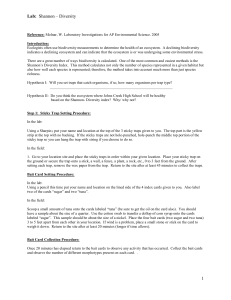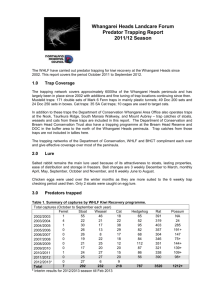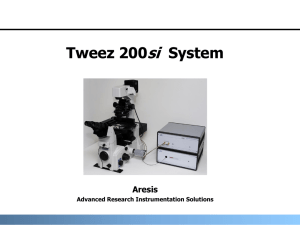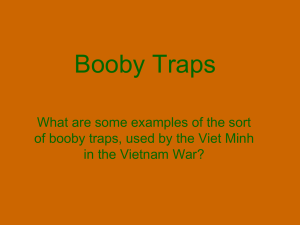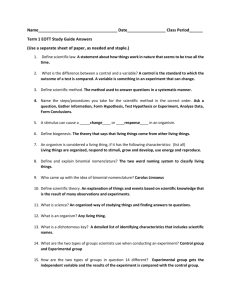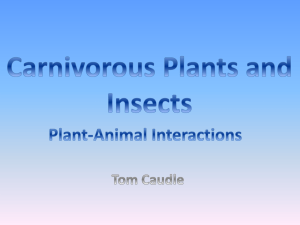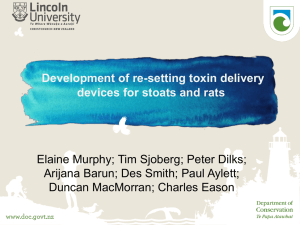STOAT CONTROL - KILL TRAPPING
advertisement
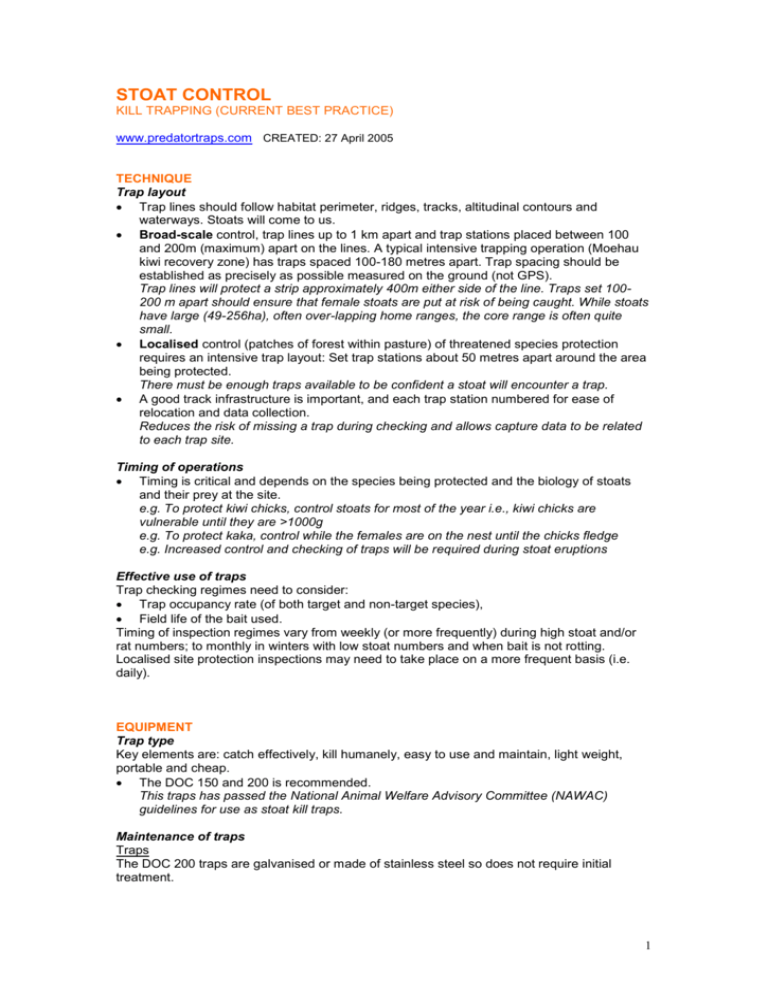
STOAT CONTROL KILL TRAPPING (CURRENT BEST PRACTICE) www.predatortraps.com CREATED: 27 April 2005 TECHNIQUE Trap layout Trap lines should follow habitat perimeter, ridges, tracks, altitudinal contours and waterways. Stoats will come to us. Broad-scale control, trap lines up to 1 km apart and trap stations placed between 100 and 200m (maximum) apart on the lines. A typical intensive trapping operation (Moehau kiwi recovery zone) has traps spaced 100-180 metres apart. Trap spacing should be established as precisely as possible measured on the ground (not GPS). Trap lines will protect a strip approximately 400m either side of the line. Traps set 100200 m apart should ensure that female stoats are put at risk of being caught. While stoats have large (49-256ha), often over-lapping home ranges, the core range is often quite small. Localised control (patches of forest within pasture) of threatened species protection requires an intensive trap layout: Set trap stations about 50 metres apart around the area being protected. There must be enough traps available to be confident a stoat will encounter a trap. A good track infrastructure is important, and each trap station numbered for ease of relocation and data collection. Reduces the risk of missing a trap during checking and allows capture data to be related to each trap site. Timing of operations Timing is critical and depends on the species being protected and the biology of stoats and their prey at the site. e.g. To protect kiwi chicks, control stoats for most of the year i.e., kiwi chicks are vulnerable until they are >1000g e.g. To protect kaka, control while the females are on the nest until the chicks fledge e.g. Increased control and checking of traps will be required during stoat eruptions Effective use of traps Trap checking regimes need to consider: Trap occupancy rate (of both target and non-target species), Field life of the bait used. Timing of inspection regimes vary from weekly (or more frequently) during high stoat and/or rat numbers; to monthly in winters with low stoat numbers and when bait is not rotting. Localised site protection inspections may need to take place on a more frequent basis (i.e. daily). EQUIPMENT Trap type Key elements are: catch effectively, kill humanely, easy to use and maintain, light weight, portable and cheap. The DOC 150 and 200 is recommended. This traps has passed the National Animal Welfare Advisory Committee (NAWAC) guidelines for use as stoat kill traps. Maintenance of traps Traps The DOC 200 traps are galvanised or made of stainless steel so does not require initial treatment. 1 Any coating applied to maintain traps should not repel stoats or attract non-targets, and be user friendly. Examples of protective coatings are: Dipping the traps in melted preserving wax, Nothing (in dry conditions), Traps in use Traps should be regularly cleaned with a wire brush. Removes mould, fur and bits of dead animals and allows for identifying what has escaped from an empty sprung trap. Un-sprung traps should be set off at 4-6 weekly intervals. A formalised maintenance regime is important. Traps should be regularly maintained, including checking for worn pivots, weakened springs. Tunnel/Cover Kill traps must be set in a tunnel or under a cover. A tunnel has three functions: i) orientate the animal relative to the trap, ii) protect the trap and iii) keep out non-target species. It must have the following: Be made of solid material. Kiwi can poke their beaks through tunnels made of wire mesh. Minimum of 600mm long. Where weka are present the tunnels need to be at least 950mm long to prevent weka accessing the traps. This provides space for two traps with double baffles on each end. Tunnel width must match the trap being used. Double baffles at each end. Restrict kiwi beaks & other non-target species. Entry holes of 50mm x 50mm cut into baffles. Allows stoats to enter but restricts non-targets. Correctly positioned, the holes help make the animal step onto the trigger plate. Solid anchorable design. Prevent traps being disturbed by pigs and possums. Removable roof. Ease of access to check/set traps. Bait is secured between the traps. Ensures bait doesn’t move or get removed. Bait and lures Key elements are: high palatability, a field life aligned with frequency of field checking, doesn’t attract non-targets, easy to use and cheap. The most effective baits may differ with location and the natural diet of stoats in the location. Stoats are flexible and opportunist in their diet. Effective baits include rabbit and fresh, white, un-cracked hen eggs. Fresh baits such as rabbit may be highly attractive to stoats but will need replacing at frequent intervals. Hen eggs are often the most practical bait because they are readily accessible, easy to store and handle in the field, and can last up to one month in cool climates. Baits should be changed regularly (timing depends on environmental conditions) and disposed of away from the trap. SKILLS REQUIRED Managers need a good working knowledge of stoat ecology and the prey ecology to manage operations effectively. Trappers should have a good working knowledge of stoat behaviour. Specific on job training in the use of traps is essential. A consistently high standard of setting traps is essential – trappers must be dedicated to the work. Trappers need sound bush navigational skills involving compass and map reading. 2 STANDARDS Animal Welfare Act 1999 Under the Animal Welfare Act 1999, NAWAC developed draft guidelines for testing kill traps. It is recommended that only traps that have passed NAWAC guidelines are used, because other traps that have not passed may be prohibited or restricted. SUSTAINING CONTROL OVER THE LONG TERM Monitoring conservation outcomes is helpful to judge effectiveness of the control programme. Control operations are useless unless outcomes are achieved. Achieving outcomes from predator control are long term and often control must take place for 5 years+ to get results. Funding must be in place for long-term control. Stoat populations are cyclic within and between years. This can result in years when anticipated outcomes are not achieved. Baits may have to be alternated and/or combined over the duration of control programme. Stoats are flexible and opportunist in their diet, so a change in abundance of their normal prey can cause a rapid shift to alternative food resources. Good data collection helps operations to be more effective and efficient over the long term. What is recorded depends on what the project wants to know. Typical questions are: What trap sites catch most /least? How much trap effort is generally required to achieve the outcome in this block? It is important to maximise trap efficiency by selecting the correct trap type, bait, layout, seasonal timing, and length of operation. LIMITATIONS There is no “window of opportunity” post control as stoat numbers quickly return to precontrol levels. Stoat re-invasion is essentially constant and rapid making effective long term control ongoing. Kill trapping for stoat control is labour intensive but sustainable and responsible. INFORMATION Recommended reading King, C. M. 1990. Stoat In C. M. King (Ed.) The Handbook of New Zealand Mammals, pp. 206-224-206. Oxford University Press, Auckland. King, C. M., Griffiths, K., Murphy, E. C. 2001. Advances in New Zealand mammalogy 1990-2000: Stoat and weasel. Journal of the Royal Society of New Zealand 31: 165-183. Department of Conservation 2002. What’s happening in stoat research? Fourth report on the five-year stoat research programme. Department of Conservation, Wellington, New Zealand. REFERENCES (SOME REFERNECES OF INTEREST) 1. 2. 3. Dilks, P. J.; O'Donnell, C. F. J.; Elliott, G. P.; and Phillipson, S. M. 1996. The effect of bait type, tunnel design, and trap position on stoat control operations for conservation management. New Zealand Journal of Zoology 23:295-306. Rudolf, P. 2000. Mustelid control and research. in Shaw, P., editor. Northern Te Urewera Ecosystem Restoration Project : Annual Report July 1998-June 1999. Dept. of Conservation, Opotiki Area Office, Opotiki, N.Z. King, C. M.; O'Donnell, C. F. J.; and Phillipson, S. M. 1994. Monitoring and control of mustelids on conservation lands. Part 2. Field and workshop guide. Department of 3 4. 5. 6. 7. 8. 9. 10. 11. 12. 13. Conservation Technical Series 4, Department of Conservation, Wellington, New Zealand. Dilks, P.; Willans, M.; Pryde, M.; and Fraser, I. 2003. Large scale stoat control to protect mohua (Mohoua ochrocephala) and kaka (Nestor meridionalis) in the Eglinton Valley, Fiordland, New Zealand. New Zealand Journal of Ecology 27(1):1-10. King, C. M. 1980. Field experiments on the trapping of stoats (Mustela erminea). New Zealand Journal of Zoology 7:261-266. Miller, C.; Elliot, M.; and Alterio, N. 2001. Home range of stoats (Mustela erminea) in podocarp forest, south Westland, New Zealand: implications for a control strategy. Wildlife Research 28:165-172. King, C. M.; Griffiths, K.; and Murphy, E. C. 2001. Advances in New Zealand mammalogy 1990-2000: Stoat and weasel. Journal of The Royal Society of New Zealand 31(1):165-183. Sim, J.; and Saunders, A., editors. 1997. National Predator Management Workshop 1997. Proceeding of a workshop held 21-24 April 1997, St Arnaud, Nelson Lakes. Department of Conservation, Wellington. Murphy, E. C.; Clapperton, B. K.; Bradfield, P. M. F.; and Speed, H. J. 1998. Effects of rat poisoning operations on abundance and diet of mustelids in New Zealand forests. New Zealand Journal of Zoology 25:315-328. Saunders, A. 2000. A review of the Department of Conservation mainland Island restoration projects and recommendations for further action. Department of Conservation, Wellington. Warburton, B. 2001. Traps and trap-testing. in Walker, A., editor. Proceedings of Mainland Island Hui, Omapere 20-23 August 2001. Department of Conservation. Thomas, M. D. 2001. Kill-traps for stoat (Mustela ermina) control. Research Investigation No. 3412, Pest Control Research Ltd., Christchurch. Department of Conservation. 2002. What's happening with stoat research? Fourth report on the five-year stoat research programme. Department of Conservation, Wellington. www.predatrortraps.com created: 27 April 2005 4


